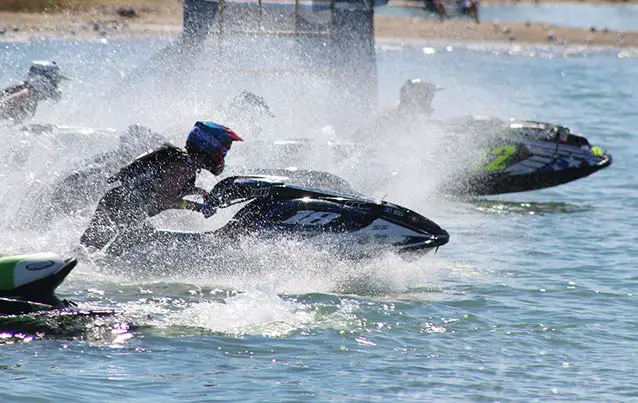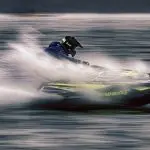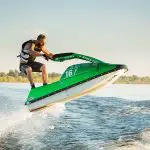Sea-Doo and Yamaha vie with one another for the vast majority of personal watercraft sales, and for good reason.
The GTI has been a cornerstone of Sea-Doo’s model line essentially since the brand’s inception, with the original GT model joining its smaller sibling the SP in 1990. Having been through several complete revamp and model year changes since, the GTI continues to be one of the best all-around values available for anything from family fun at the lake to ocean cruising.
Yamaha’s EX line-up only made its debut in 2017, but immediately became the GTI’s most prominent competitor.
So how do the two compare? First, we’ll look at what you get for your money. And then we’ll get into the completion aspect.
Contents
Yamaha EX
Yamaha bills the EX line-up as “Rec Lite” and that seems a bit of a misnomer. The 580-pound EX at 10 feet four-inches long is certainly big enough for family fun. It will easily handle a (moderately heavy) three-passenger load, handles well in fairly rough water conditions, and is also up to the task of towing skiers or tubers.
At the base level, the EX powerplant is Yamaha’s 100-horsepower 1049cc three-cylinder four-stroke. A hundred ponies is enough to push the Deluxe just over the 50 mph threshold, and an EX accelerates nicely.
The hull design combines with the relatively light weight of the boat to offer a handling package nicely reminiscent of smaller and more playful watercraft of days gone by. It’s not as planted deep in the water as its bigger brothers, and offers an ample helping of playful agility while nonetheless remaining plenty stable. It’s a fun and versatile ride.
The base model EX is the most affordable three-seat personal watercraft on the market with an MSRP of just $7,199, and represents a tremendous value.
Some, however, might see the value of stepping up to the next model, the Sport, despite the $1100 price jump in order to have a reverse mode – or even to the notably more expensive EX Deluxe or EX Limited in order to have fully modern reverse and deceleration available.
Riders that are newer to the scene have come to expect some sort of reverse function. And even more, experienced riders have embraced the sizable advantage of being able to “brake” when the situation calls for it.
Certainly, a reverse mode does allow for easier docking and maneuverability at low speeds.
The $8299 EX Sport has a system akin to the first reverse mechanisms, a simple bucket that drops down over the jet pump to artificially reverse the flow of water – and direction.
With the more expensive EX Deluxe and EX Limited – $9299 and $9899, respectively – Yamaha’s much more sophisticated RiDE system from its more expensive models is included.
With the RiDE system, a “throttle” trigger is mounted on the left side handlebar, opposite the actual throttle. The Yamaha system actually reverses water flow to facilitate deceleration.
There is a slight weight penalty, with the RiDE equipped models weighing in about 20 pounds heavier than the less expensive versions.
The EX Deluxe and EX Limited are essentially identical, with the limited package including not extra features on the boat but rather extra accessories such as a color-matched tow tube, rope, and inflator.
Yamaha’s EX line does not include cruise control, variable trim, or a learner mode. But at a price point that is thousands less, these features might be considered superfluous by a buyer simply concerned with the most bang for the buck.
So let’s take a look at the GTI package, then we’ll do a little comparing and contrasting that might help you to determine which is the best choice for you or your family.
Sea-Doo GTI
In the early days the GTI shared the flagship GTX hull design and it does again today. Sea-Doo updated the GTI to the current GTX hull in 2020, and now as back when the base model is nearly the equal of its more muscular brother in many ways.
The Sea-Doo GTI is available with differing levels of power output. All have the same level of comfort and stability. The GTI hull is designed with a low center of gravity, providing both stability and a very planted feel in the water.
The lion’s share of the difference comes underneath the seat, where horsepower levels vary according to how deeply in your pocket you are willing to reach.
At the low end of the line, $9299 buys you the 90-horse version of Sea-Doo’s 899cc ACE three-cylinder engine. For just a thousand bucks more, you can bump up to the GTI 130 which offers an eponymous 130 horsepower.
The former limits you to a relatively sedate top speed in the low 40 mph range, while the latter brings you closer to the 50 mph threshold.
For $11,699, the Sea-Doo GTI SE comes with 170 ponies. This puts one very close to a 60 mph top speed.
The standard GTI weighs in at 668 pounds, and the most powerful weighs 730. The recommended passenger weight capacity for the GTI series is 600 pounds.
All of the GTI models come equipped with Sea-Doo’s IBR system, an acronym standing for “intelligent brake and reverse.”
Sea-Doo also offers a vast array of add-ons such as depth finders, GPS units, and premium audio systems.
So which one is better, the WaveRunner EX, or the Sea-Doo GTI?
Which is the best boat for you pivots on your personal tastes, wants, and needs.
Handling
Personally, I really prefer the handling package of the lighter and more playful Yamaha. With the proper body positioning, the EX can weave and cut through corners as well or better than other boats on the market, and yet it still lends itself well to slides and spins and the shenanigans that draw me to runabouts in the first place.
However, there’s no arguing that the larger and heavier GTI offers more comfort and stability. It’s based on the most proven and arguably most popular three-seat hull ever made, and if you are more interested in carrying a full passenger load in comfort through even the choppiest of waters, it’s a bit of a luxury liner in direct comparison to the WaveRunner.
Acceleration
The base model (or any) Yamaha EX is more than the equal of Sea-Doo’s base 90-horsepower GTI. The WaveRunner’s 10 additional ponies plus its 68-pound lighter weight means that the EX will practically suck the graphics right off a GTI as you go flying by.
That margin of difference can be nearly erased by bucking up to the GTI 130, as top speeds become much more equal. Still, to the seat of my pants, the Yamaha accelerates harder from a dead stop into a solid and meaty mid-range while even the GTI 130 feels a bit more relaxed and sedate. Slower, in a word.
Carrying Capacity
There is no question that the GTI is more of a true three-seater. It is longer, wider, heavier and its claimed passenger weight capacity of 600 pounds is probably pretty accurate. (I can’t say for sure, I’m just 6-foot-1 and 190 pounds, and the girls I might give a ride to are unfailingly smaller than me.) The GTI is super stable, and would be the superior choice if taking all the kids and neighbors onboard.
The EX is a bit in the inverse. It is a three-seater, but only just. Yamaha claims a load capacity of 529 pounds, but I’d shave about 50 off that number. (Not that I’ve ever come anywhere close to that in personal experience, but it is certainly not as large or as stable as its heavier-boned competition. Which, again, is what I like about it, but your mileage may vary.
Reverse System
Again, the EX base model has no reverse whatsoever. I shrug at that, others won’t. I’d also be perfectly happy with the old-school bucket reverse. However, time marches on and newer riders might be lost without that function.
The more expensive EX does include Yamaha’s RiDE system, allowing for a bit of a head-to-head comparison with Sea-Doo’s iBR braking and reverse system. Honestly, though, it’s a bit of a non-issue. Though using slightly different methods, both systems work quite well and become intuitive to use in relatively short order.
Both systems opt for relocating the reverse actuation from the console to the handlebars, a welcome change that allows one to look where they’re going and keep their hands on the wheel, as it were, instead of pawing around blindly for a lever beside their knee or failing to look at any hazard ahead.
Cooling System
This is getting into gearhead territory, but it’s probably worth noting the differences in how Yamaha and Sea-Doo cool their motors.
Sea-Doo is the only manufacturer to adopt a closed-loop cooling system. Not unlike a passenger car, the Sea-Doo has antifreeze that circulates around the motor and is always in the system. Sea-Doo cleverly utilizes the ride plate underneath the jet pump as a radiator, essentially, allowing the water you are riding in to cool the water your engine uses.
This is more of a factor for ocean riders than those who will mostly use their watercraft in lakes and rivers. Although the cleanliness of lake or river water can vary quite a lot from region to region depending on your location, there is nothing inherently corrosive about it. Salt water, on the other hand, is extremely corrosive. If you are new to personal watercraft, know that your boat should be thoroughly flushed out with clean water from a hose after every ride. You can read more about that process here.
The Yamaha uses the tried and true open-loop cooling method, in which you are effectively riding in your coolant. The engine uses pick-ups to suck whatever is floating your boat into the cooling channels within the engine. It’s simpler, doesn’t require special antifreeze to be monitored or replaced, and is how every other manufacturer does it – and how Sea-Doo previously did it for decades.
Wrapping Up
As stated previously, it really just comes down to what kind of riding you want to do. If you’re a bit more into touring around and enjoying the ambiance and scenery, the GTI is the more comfortable and stable platform from which to do it.
But if you want to spin, slide, and play, the Yamaha holds those cards. For me, the EX is lighter and a touch smaller than the Sea-Doo while still absolutely large enough to provide a family-friendly platform at a very reasonable price.






